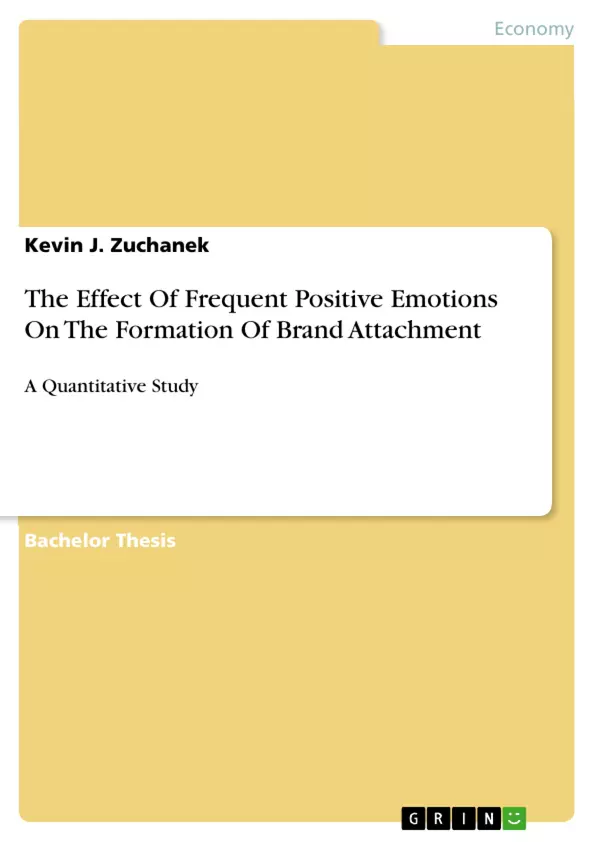This paper aims to show the effect of frequent positive emotions on the formation of brand attachment. Therefore, this paper will start by looking at several current research findings to determine definitions for divisive terms and to build up a conceptual framework which supports the constructed hypotheses on the formation of brand attachment.
More endorsement is given by a realized quantitative study which researches positive emotions and constituents of dependent variables like brand attachment. Even though variances are inevitable, a study on the topic ought not to be rendered to be redundant, since the topic lacks scientific studies, in comparison to other economic fields, due to novelty. By juxtaposing the framework and study in opposition to the hypotheses, one will see to which extent frequent positive emotions lead to positive outcomes which results then find their way into marketing departments and provide action alternatives.
Current researches have discovered that there is a connection between feeling good and attaching oneself to an entity. This entity referred in the past exclusively to human entities, however, economists are emphasizing the equality between human beings and inhuman entities, like brands. Happiness, as already mentioned, is a value which is hard to capture, because of the lack of a universal definition and also because feelings are difficult to inquire into due to the fact that present circumstances always have their effects on the current state of an individual. This makes variances in the measurement of happiness inevitable.
Inhaltsverzeichnis (Table of Contents)
- 1. Introduction
- 2. Conceptual Framework
- 2.1. Happiness
- 2.1.1. Definition of Happiness
- 2.1.2. Broaden-and-Build Theory
- 2.2. Brand Attachment
- 2.2.1. Self-Expansion Model
- 2.2.2. Definition of Brand Attachment
- 2.3. Formation of Hypotheses
- 3. Study
- 3.1. Structure of the Study
- 3.2. Data Cleansing and Data Preparation
- 3.3. Evaluation
- 3.3.1. Hypothesis 1: PA Leads to the Usage of New Brands
- 3.3.2. Hypothesis 2: New Perceptions of Various Facets mediates BSC
- 4. Conclusion
Zielsetzung und Themenschwerpunkte (Objectives and Key Themes)
This thesis investigates the influence of frequent positive emotions on the formation of brand attachment. It aims to explore the relationship between positive affect and brand-related behaviors, particularly the adoption of new brands. The study utilizes a quantitative approach to analyze data collected through a survey.
- The impact of positive affect on brand usage
- The role of brand-self connection in brand attachment
- The mediating effect of new perceptions of various facets on brand-self connection
- The application of the Broaden-and-Build Theory to brand attachment
- The use of quantitative research methods to study consumer behavior
Zusammenfassung der Kapitel (Chapter Summaries)
The first chapter provides an introduction to the topic of brand attachment and its relationship with positive affect. It outlines the research question and the study's objectives. Chapter 2 presents the conceptual framework, defining key terms such as happiness, brand attachment, and brand-self connection. It also introduces the relevant theories, including the Broaden-and-Build Theory and the Self-Expansion Model. Chapter 3 details the study's methodology, including the data collection and analysis methods employed. It also presents the findings for each hypothesis tested.
Schlüsselwörter (Keywords)
This study focuses on the key concepts of positive affect, brand attachment, brand-self connection, and the Broaden-and-Build Theory. It utilizes a quantitative approach to analyze data, employing statistical methods and techniques. Key terms include: brand, brand attachment, brand-self connection, positive affect, happiness, subjective well-being, new perceptions, usage, and quantitative research.
- Quote paper
- Kevin J. Zuchanek (Author), 2018, The Effect Of Frequent Positive Emotions On The Formation Of Brand Attachment, Munich, GRIN Verlag, https://www.grin.com/document/542372



